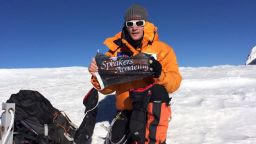Story highlights
A Sherpa, a Dutch man, an Australian woman and two Indian men are among the deaths
One Indian climber remains missing
The body of one of two Indian nationals who went missing on Mount Everest last week has been located, the managing director of Trekking Camp Nepal said Friday.
Paresh Chandra Nath is the fifth person to die climbing the world’s highest peak this season.
A team of Sherpas located Nath’s body Friday morning but were unable to carry it to base camp because of weather conditions, Wangchu Sherpa told CNN.
Another member of Nath’s climbing team, Goutam Ghosh, is missing, Wangchu Sherpa said.
The two men were part of a team of four Indian climbers and four Sherpas. Indian national Subash Paul died at Base Camp II – at an elevation of about 24,600 feet – Sunday from altitude sickness.
Avalanches killed 35 climbers on Mount Everest the past two years – including 16 in one devastating day in 2014. At least one person has died climbing the mountain in Nepal every year since 1990.
And now the 2016 climbing season has claimed its first victims.
The recent deaths – coming so quickly on the heels of one another – have rattled climbers who are beginning their descent as the Everest climbing season nears its end. April and May are the most common months to attempt a climb because there tends to be less wind. Regardless, the climate on the mountain is brutal. Temperatures range from -31 to -4 Fahrenheit.
April was the first month of climbing since all ascent was halted after the catastrophic earthquake that struck Nepal in 2015 and a deadly avalanche that killed 16 Sherpas in one day in 2014. More than 200 climbers have died since Tenzing Norgay and Edmund Hillary made the first official ascent in 1953.
Everest summit reached for first time after two years
Last week, crew member Phurba Sherpa (no relation to the journalist of the same name) fell to his death. The 25-year-old had been working to fix a route about 150 meters near the summit when he fell Thursday, according to Mingma Sherpa, the Nepal rescue team leader who was at the Everest Base Camp.
The Sherpa people are an ethnic group from Nepal who have lived in the high altitudes of the Himalayas for generations. They have long served as guides whose local expertise has been invaluable for foreigners attempting Everest climbs.
Eric Arnold, 36, of the Netherlands, died Friday night while heading back after a successful summit on Everest, according to Tashi Lakpa Sherpa, the owner of Seven Summit Treks. A heart attack was suspected, he said.

Arnold was a triathlete based in Rotterdam, according to his Twitter bio.
An Australian woman, Maria Strydom, who was also traveling with the Seven Summit Treks, started suffering altitude sickness last Saturday. She had reached Camp IV, the final camp before the summit.

Strydom, 34, could not climb any higher and a rescue attempt to reach her failed, according to Tashi Sherpa. The finance professor at Monash Business School in Australia died Saturday before she could come back down to Camp III.
Strydom gave an interview with the school in March detailing her ambition to climb the highest summit on each of the seven continents. She had already climbed Denali in Alaska, Aconcagua in Argentina, Mount Ararat in eastern Turkey and Kilimanjaro in Africa. She had planned to climb Everest with her husband, inspired in part by questions the couple received about their vegan diet.
Her mother, Maritha Strydom, had been following her daughter’s progress on her ascent through a series of satellite “pings” from her phone.
“I was worried when the pings stopped, and we started calling but no one could give us any answers,” Strydom told CNN in an interview from Brisbane, Australia, this week. “So my other daughter … Googled and found in the Himalayan Times that my daughter had passed away.”
Strydom believes her daughter was in the “death zone” for too long.
What can happen to your body on Everest
The death zone refers to altitudes higher than 8,000 meters (about 26,200 feet), where the risk of dying significantly climbs. There is little oxygen here, so altitude sickness is common and can be deadly. Temperatures tumble, winds intensify and frostbite can hit any exposed part of the body. The ground is icy, so falls are not uncommon.
“No one is supposed to stay in the death zone longer than 16 to 20 hours. If you stay there longer you will be dead,” Strydom told CNN.
Nath’s climbing companion Paul, 44, died Sunday at Base Camp II from altitude sickness, according to Wangchu Sherpa.
“It is not clear what happened. We believe the weather suddenly deteriorated at some point, and the team lost direction,” Wanchu Sherpa said.
A fourth climber from the team, Sunita Hazra, was rescued and was undergoing treatment at base camp.
Exploring Mount Everest
Phurba Sherpa reported from Nepal; Ray Sanchez, Brandon Griggs, Ashley Fantz, Madison Park and Tiffany Ap also contributed to this report.












































